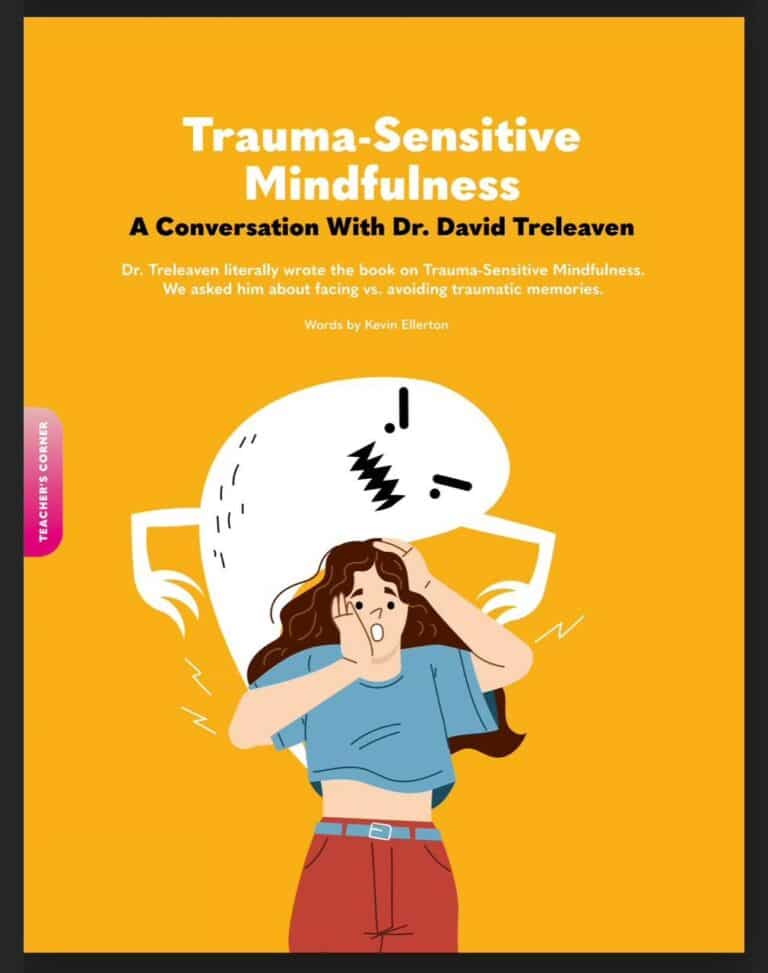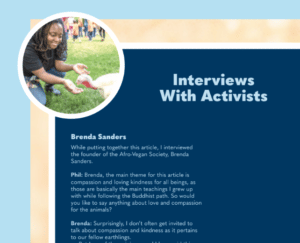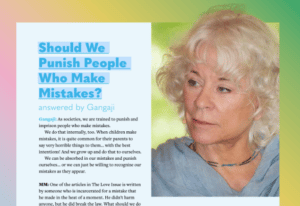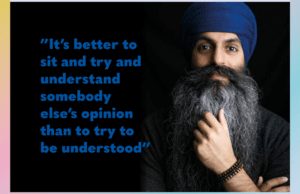Healing Trauma Through Meditation: A Conversation With Dr. David Treleaven
In the long history of psychology & healthcare, Trauma-Informed Care (or TIC) is a relatively new concept.
First proposed by Maxine Harris and Roger Fallot in 2001, TIC aims to recognize the unique needs of trauma-survivors, and adapt our healthcare systems to better serve those who are experiencing the lingering effects of trauma.
Newer still is the application of TIC to the world of mindfulness & meditation. While meditation itself dates back into prehistory (well before Gautama sat under the Bodhi tree 2,500 years ago), the first mention of Trauma-Informed Mindfulness (TI-Mindfulness) in the scientific literature dates back to 2014 (less than ten years ago), when Amber R. Kelly proposed (in her doctoral dissertation) “Trauma-Informed Mindfulness-Based Stress Reduction” as a new model for working with people who have survived interpersonal trauma.
In 2018, Dr. David Treleaven (who has been specializing in mindfulness and trauma for over a decade) published his groundbreaking book, Trauma-Sensitive Mindfulness, which demonstrates an empathic, compassionate, balanced approach for mindfulness instructors to work more sensitively and skillfully with trauma survivors.
As with any new field of study, TI-Mindfulness has met with some skepticism from “traditionalists” within the fields of mindfulness & meditation.
Traditional meditation practices (especially the techniques from the mindfulness/Buddhist traditions) encourage us to observe, accept, and befriend our most difficult thoughts, sensations, and emotions, rather than running away from them. In many traditions, the willingness to face our deepest fears is one of the most important aspects of the practice.
We are currently living in a time when meditation & mindfulness are being touted by mainstream media and modern McMindfulness mavens as “relaxation techniques” – emphasizing relaxation and calmness, while brushing off the (often difficult) work of sitting equanimously through the raging storms inside. Traditional meditation teachers tend to view this trend toward meditation-as-relaxation as problematic, because it provides new meditators with an incomplete, watered-down “meditation” practice, and causes them to miss out on some of meditation’s most important and powerful components.
Much of the guidance in TI-Mindfulness centers around the avoidance of bringing up traumatic memories in the mind & body of the trauma survivor. There are recommendations to avoid using words in meditation that might “trigger” or “activate” the survivor. There are suggestions on how to calm survivors down, pull them out of traumatic memories, and prevent them from going into states of fear, panic, and hyperarousal.
Meanwhile, modern science has consistently corroborated the ancient wisdom that avoiding traumatic memories is actually one of the worst things that survivors can do… and that, in fact, mindfulness & acceptance are the path toward healing. To quote one major literature review on mindfulness & trauma:
“Mindfulness and acceptance are associated with greater psychological adjustment following exposure to trauma, while experiential avoidance, persistent dissociation, and coping strategies involving emotional disengagement are associated with greater PTSD symptom severity.”
Thompson, R. W., Arnkoff, D. B., & Glass, C. R. (2011). Conceptualizing Mindfulness and Acceptance as Components of Psychological Resilience to Trauma. Trauma, Violence, & Abuse, 12(4), 220–235.
For these reasons, some traditional meditation teachers have viewed TI-Mindfulness with skepticism, worrying that it promotes the avoidance of difficult thoughts, sensations, and emotions, in favor of short-term experiences of relaxation & calm.
But diving into Dr. Treleaven’s book, Trauma-Sensitive Mindfulness, we can find a balanced, nuanced, and sophisticated approach to working with trauma. Dr. Treleaven often explains that the aim of TI-Mindfulness is not to avoid thoughts, sensations, and emotions, but rather to work more skillfully with them, moderate them as needed, and access them at a pace that is healthy and manageable for each individual meditator.
TI-Mindfulness is still an emerging field of study. Its insights will need to be fleshed out more fully, so that we can integrate them skillfully into our meditation teaching (and personal) practices.
Reflections on Trauma-Informed Mindfulness
A Q&A with Dr. David Treleaven
Introduction & Questions by Kevin Ellerton. Answers by Dr. Treleaven
Hi Dr. Treleaven!
In my interviews with meditators, gurus & spiritual teachers around the world, I’ve observed two basic approaches to working with pain and suffering. These methods cannot be implemented simultaneously, so people generally lean toward one or the other. For simplicity, let’s call these two approaches “The Relief Approach” vs “The Acceptance Approach.”
The Relief Approach
In The Relief Approach, when we encounter pain and suffering, in ourselves or others, our goal is to relieve it. We aim to change, improve, transform, or get rid of something that we find to be problematic, painful, or uncomfortable, and to shift into more “positive” states, like calm, relaxation, peace, and happiness. The Relief Approach tends to be the “default” paradigm for western medicine.
The Acceptance Approach
In The Acceptance Approach, when we encounter pain and suffering, our goal is to stop trying to relieve it. Instead of trying to get rid of pain or change our experience, we accept it, befriend it, and even love it. When we (truly, consciously and unconsciously) accept pain and suffering, and stop trying to relieve them, we let go of the idea that they are “negative” or “problematic.” We realize that while pain and suffering may still be arising, our relationship with those experiences can be peaceful, friendly, and even loving. The Acceptance Approach tends to be less intuitive to us in the west, as it goes against our evolutionary drive to “make things better.” Acceptance of pain & suffering is fundamental to many of the eastern spiritual/contemplative traditions. Indeed, one of Buddha’s core teachings is that dukkha is inevitable, and equanimity (non-judgmental awareness) is the path to ultimate freedom from suffering.
Pros & cons of each approach
Each of these approaches has pros and cons. With The Relief Approach, we can completely “feel better” and “get rid of the pain.” In the short term, Relief seems like “The Solution” to pain. But when the next moment of pain inevitably comes along, we find ourselves suffering again, in an endless struggle to “make it stop.” With The Acceptance Approach, we are literally giving up on the idea of pain relief, which some may view as capitulation. But the advantage of this approach becomes apparent in the long term. When the next moment of pain comes along, the attitude of acceptance is already in place, and so the pain does not become a “problem.” We live in a state of lifelong “happiness,” rather than going up and down on a roller coaster of pleasure and pain.
Finding balance between the two approaches
We can use different approaches in different situations. We may aim for Relief in some situations, while practicing Acceptance in others. This balancing act is encapsulated in the famous prayer: “God, grant me the serenity to accept the things I cannot change, courage to change the things I can, and wisdom to know the difference.”
But we can’t apply both approaches at the same time. The Relief Approach is founded on the idea that “pain is a problem that needs to be fixed.” In order to motivate ourselves to take action to relieve the pain, we must hold this “problem” idea in our minds, until it is “fixed.” The Acceptance Approach, on the other hand, is founded on completely letting go of that idea — that “pain is a problem that needs to be fixed” — which is precisely the thing that prevents us from accepting pain in the first place. We cannot hold an idea in mind, and let it go at the same time. Therefore, we are unable to work toward relieving pain while at the same time (fully) accepting it… and we are unable to truly accept pain without giving up the goal of relieving it.
Ideally, we can select the appropriate approach for each situation. I’ve observed that many traditional meditation teachers (monks and gurus in monasteries and ashrams, for example) tend to favor The Acceptance Approach in nearly all situations — even for those involving extreme pain (grief after tragedy, intense physical pain, etc). They switch over to The Relief Approach only when Acceptance can cause long-lasting damage (for example, if you are damaging the tendons in your knees by sitting in a certain meditation posture, the instruction is to adjust to a more comfortable position). Western medical professionals, on the other hand, tend to favor Relief over Acceptance, and only “give in” to Acceptance when The Relief Approach fails.
Where does Trauma-Informed Mindfulness fit in?
The TI-Mindfulness Movement is a child of two very different parents. The “Trauma Informed” perspective is born out of the western medical paradigm of Relief, while the “Mindfulness” is rooted in eastern spiritual traditions of acceptance. This places TI-Mindfulness in a tricky spot: do we approach trauma with the goal of Relief — avoiding activating traumatic memories, cultivating states of calm and relaxation, staying within the window of tolerance, etc? Or do we approach trauma with the goal of Acceptance — allowing traumatic memories to arise, allowing states of calm/relaxation and anxiety/tension to come and go, allowing ourselves to flow in and out of our window of tolerance, etc?
Q&A WITH DR. TRELEAVEN
- Can The Acceptance Approach ever be appropriate for working with trauma survivors, or should we always lean toward Relief?
Yes, the Acceptance Approach is very appropriate for work around trauma. In fact, it’s essential!
What I point to in my work is that it needs to be a blend between what you call “acceptance” and “relief.” Trauma survivors can learn to “accept” traumatic sensations, for example, but there are also times to back off in the service of healing. More is not always better with Acceptance, and we need to employ a wide range of tools in practice.
- In your book, Trauma-Sensitive Mindfulness, you mention the possibility that trauma survivors may “re-traumatize” themselves in mindfulness practice, and thereby incur lasting damage in their attempts to practice mindfulness. What would re-traumatization look like? Have you ever seen it in practice, or in scientific studies? Could re-traumatization be avoidable by approaching the practice with a goal of equanimity and Acceptance (rather than Relief), as described above?
Re-traumatization in practice can look like extreme dissociation, or reliving traumatic events in a dysregulating way. This has been documented in the Varieties of Contemplative Experience study1, which is the largest qualitative study on meditation-related difficulties ever held.
Re-traumatization can absolutely be avoided by employing a mix of “relief” and “acceptance” practices, where it’s okay to back off of traumatic memories or sensations when it’s overwhelming.
This isn’t to say the point of meditation is to be comfortable – on the contrary, we’re practicing so that we’re able to stay with difficult experiences. But traumatized people need more than just basic acceptance and mindfulness-based practices to work skillfully and safely with trauma.
1. Lindahl, J., Fisher, N., Cooper, D., Rosen, R., and Britton, W. (2017). “The Varieties of Contemplative Experience: A Mixed-Methods Study of Meditation-Related Challenges in Western Buddhists.” PLOS ONE 12(5): e0176239
- Are you aware of any scientific studies that have compared the effectiveness of The Relief Approach vs The Acceptance Approach (or TI-Mindfulness vs traditional equanimity-oriented instructions) in the general population, or in PTSD sufferers?
No this is still a new area, I’m not aware of any such studies.
- In your book, Trauma-Sensitive Mindfulness, you talk about the “Window of Tolerance” — the “safe” zone between hypo-arousal and hyper-arousal. The implication is that when we are inside our Window, we are able to self-regulate, grow, and heal… but when we are outside our Window, we are unable to grow or heal through mindfulness & equanimity. However, in some contemplative traditions, practitioners intentionally put themselves into states of hypo or hyper-arousal as a way to practice equanimity, expand their Windows of Tolerance, and bring Acceptance into every aspect of life. As an extreme example, the Aghoris of India meditate with corpses in graveyards, ingest high doses of mind-altering drugs, and generally spin dizzily, chaotically, and euphorically through the ups and downs of life. It occurs to me that this type of Radical-Acceptance approach could be a possible alternative for working with dysregulating thoughts, sensations, and emotions, like those that arise in the minds and bodies of trauma survivors. What is your take on this?
There are absolutely times to push our edges in practice. These experiences can create life-changing breakthroughs. With trauma, things are a bit more complicated. Trauma survivors often need to confront their trauma, but if they do so with too much intensity, they can overwhelm their nervous system.
In Trauma-Sensitive Mindfulness, the work is to help people learn how to self-regulate when they’re feeling overwhelmed. The goal isn’t to avoid trauma, or always stay in a window of tolerance. It’s to empower trauma survivors with tools to help them work skillfully with their own experience.

To get this issue (and also get 4 more issues in your first year), don’t forget to subscribe! Digital mag | print magazine!














